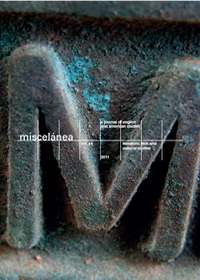Reading the Helicon Collage: Hidden Stories in the Collected Fragments
DOI:
https://doi.org/10.26754/ojs_misc/mj.20119085Palabras clave:
Edad moderna temprana, Virgilio, Antologías, Modelos de lectura, SecuenciasResumen
El presente estudio se propone demostrar que la antología pastoril Englands Helicon puede leerse como una compilación de poemas separados o fragmentos, o de fragmentos intercalados con secuencias de poemas que forman historias de amor aquí y allá a lo largo de la antología. Con este objetivo, se han seguido los modelos clásicos de las Églogas II y VII de Virgilio, de modo que la reconstrucción de la secuencia se basará en un análisis de dichos modelos, tomando la secuencia como una imitatio cum variatione de las dos églogas. Ambas posibilidades eran igualmente válidas para los lectores del siglo XVII que conocían la tradición literaria de la época. Todo dependía de cómo decidieran acercarse al texto. Este estudio también sostiene que la mayoría de los lectores contemporáneos -a menos que sean especialistas en literatura de la Edad Moderna- necesitarían que se les proporcionaran las herramientas adecuadas para poder organizar los fragmentos en historias de amor, es decir, para leer los poemas del Helicón en secuencia.Descargas
Referencias
Barnfield, Richard. 1594. The Affectionate Shepheard. Containing the Complaint of Daphnis for the love of Ganymede. London: Iohn Danter.
Chapman, George. 1595. Ovids Banquet of Sence: A Coronet for his Mistresse Philosophie, and his Amorous Zodiacke. With a Translation of a Latin Coppie, Written by a Fryer, anno Dom. 1400. London: Iames Roberts, Richard Smith.
Clausen, Wendell. 1997. A Commentary on Virgil: Eclogues. Oxford: Clarendon Press.
Clitheroe, Fred (ed.) 1992. The life and selected writings of Richard Barnfield 1574-1627. Newcastle: Lymes Press.
Daalder, Joost. Review of Klawitter, George (ed.) 1993. “The complete poems of Richard Barnfield”. Review of English Studies 44: 175.
Domínguez, Elena. 2002.“‘By cruell love now slaine’: Virgilian structures and themes in Englands Helicon”. SEDERI XI: 59-65.
Fernández-Galiano, Manuel. 1984. Títiro y Melibeo: la poesía pastoril grecolatina. Madrid: Fundación Pastor de Estudios
Clásicos.
Foote Crow, Martha (ed.) 1896. Elizabethan Sonnet Cycles. Phillis by Thomas Lodge and Licia by Giles Fletcher. London: Kegan Paul, Trench, Trübner and Co.
Giantvalley, Scott. 1981. “Barnfield, Drayton, and Marlowe: Homoeroticism and Homosexuality in Elizabethan Literature”.
Pacific Coast Philology 16:2.
Hughes Fowler, Barbara. 1994. Vergil’s Eclogues. Chapel Hill: University of North Carolina Press.
Jusserand, J.J. 1966. The English Novel in the Time of Shakespeare. Trans. by Elizabeth Lee. Ed. Philip Brockbank. London and New York: E. Benn, Barnes & Noble.
Klawitter, George (ed.) 1990. Richard Barnfield: The Complete Poems. Selinsgrove: Susquehanna UP.
Montemayor, Jorge de. 1996. La Diana. Montero, Juan. Ed. Barcelona: Crítica.
Morris, Harry. 1960. “Richard Barnfield: The Affectionate Shepheard”. Tulane Studies in English: 13-38.
Richmond, H.M. 1960. “Polyphemus in England: A Study in Comparative Literature”. Comparative Literature 12: 229-242.
Rollins, H.E. (ed.) 1935. Englands Helicon. Cambridge (MA): Harvard U.P.
Rushton Fairclough, H (Trans). 1999-2000 (1916). Virgil. Cambridge, Mass: Harvard U.P.
Smith, Bruce R. 1994. Homosexual Desire in Shakespeare’s England. Chicago: University of Chicago Press.
Smith, Hallet. 1952. A Study in Conventions, Meaning, and Expression. Cambridge (MA): Harvard U.P.
Tudeau-Clayton, Margaret. 1998. Jonson, Shakespeare, and Early Modern Virgil. Cambridge: Cambridge UP.
Vélez Núñez Rafael. 2004. “Bucolic Uneasiness: A Comparative Study of Translations and Adaptations of Virgil’s Second Eclogue in Early Modern England”. BELLS: Barcelona English Language and Literature Studies 13.
Virgilio. 1996. Bucólicas. Cristóbal, Vicente (ed.) Madrid: Cátedra.
Descargas
Publicado
Número
Sección
Licencia

Esta obra está bajo una licencia internacional Creative Commons Atribución-NoComercial 4.0.


